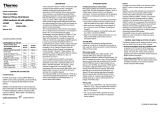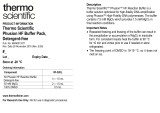Page is loading ...

PRODUCT INFORMATION
DNase I, RNase-free
Pub. No. MAN0012000
Rev. Date 05 April 2016 (Rev. B.00)
Lot: ____ Expiry Date: _
Components
#EN0521
1000 U
#EN0523
HC, 1000 U
#EN0525
1000 U
Concentration
1 U/µL
50 U/µL
1 U/µL
10X Reaction Buffer
with MgCl2
1.25 mL
1.25 mL
1.25 mL
10X Reaction Buffer
without MnCl2
-
-
1 mL
100 mM MnCl2
-
-
1 mL
50 mM EDTA
1 mL
1 mL
1 mL
Store at -20 °C
www.thermofisher.com
For Research Use Only. Not for use in diagnostic procedures.
Description
DNase I iis an endonuclease that digests single- and
double-stranded DNA. It hydrolyzes phosphodiester bonds
producing mono- and oligodeoxyribonucleotides with
5’-phosphate and 3’-OH groups.
The enzyme activity is strictly dependent on Ca2+ and is
activated by Mg2+ or Mn2+ ions:
in the presence of Mg2+, DNase I cleaves each strand of
dsDNA independently, in a statistically random fashion (1);
in the presence of Mn2+, the enzyme cleaves both DNA
strands at approximately the same site, producing DNA
fragments with blunt ends or with one or two nucleotide
overhangs (1).
Applications
Preparation of DNA-free RNA (1).
Removal of template DNA following in vitro transcription (1),
see protocol on reverse page.
Preparation of DNA-free RNA prior to RT-PCR and
RT-qPCR (2), see protocol on reverse page.
DNA labeling by nick-translation in conjunction with DNA
Polymerase I (1), see protocol on reverse page.
Studies of DNA-protein interactions by DNase I, RNase-free
footprinting (1).
Generation of a library of randomly overlapping DNA inserts.
Reaction buffer containing Mn2+ is used (3).
Source
E.coli cells with a cloned gene encoding bovine DNase I.
Rev.12 V

Molecular Weight
29 kDa monomer.
Definition of Activity Unit
One unit of the enzyme completely degrades 1 µg of plasmid
DNA in 10 min at 37 °C.
Enzyme activity is assayed in the following mixture:
10 mM Tris-HCl (pH 7.5 at 25 °C), 2.5 mM MgCl2,
0.1 mM CaCl2, 1 µg of pUC19 DNA. One DNase I unit is
equivalent to 0.3 Kunitz unit (4).
Storage Buffer
The enzyme is supplied in: 50 mM Tris-HCl (pH 7.5),
10 mM CaCl2 and 50% (v/v) glycerol.
10X Reaction Buffer with MgCl2
100 mM Tris-HCl (pH 7.5 at 25 °C), 25 mM MgCl2, 1 mM CaCl2.
10X Reaction Buffer without MnCl2
100 mM Tris-HCl (pH 7.5 at 25 °C), 1 mM CaCl2. Recommended
concentration of MnCl2 in 1X reaction buffer is 10 mM.
Inhibition and Inactivation
Inhibitors: metal chelators, transition metals (e.g., Zn) in
millimolar concentrations, SDS (even at concentrations less
than 0.1%), reducing agents (DTT and β-mercaptoethanol),
ionic strength above 50-100 mM.
Inactivated by heating at 65 °C for 10 min in the presence of
EGTA or EDTA (use at least 1 mol of EGTA/EDTA per 1 mol of
Mn2+/Mg2+ (5)).
Note
Thermo Fisher Scientific offers a good alternative to the stand-
alone DNase I enzyme for gDNA removal from RNA samples -
RapidOut DNA Removal Kit (K2981). Kit contains DNase I,
RNase-free and a proprietary DNase Removal Reagent for
efficient DNase I removal.
CERTIFICATE OF ANALYSIS
Ribonuclease Assay
Incubation of RNA transcript with DNase I.
Quality authorized by: Jurgita Zilinskiene
(continued on reverse page)

Removal of genomic DNA from RNA preparations
1. Add to an RNase-free tube:
RNA
1 µg
10X reaction buffer with MgCl2
1 µL
DNase I, RNase-free (#EN0521)
1 µL (1 U)
DEPC-treated Water (#R0601)
to 10 µL
2. Incubate at 37 °C for 30 min.
3. Add 1 µL 50 mM EDTA and incubate at 65 °C for 10 min.
RNA hydrolyzes during heating with divalent cations in the
absence of a chelating agent (5). Alternatively, use
phenol/chloroform extraction.
4. Use the prepared RNA as a template for reverse transcriptase.
Note
Do not use more than 1 U of DNase I, RNase-free per 1 µg of
RNA.
If using DNase I, HC, enzyme can be diluted in 1X DNase
reaction buffer just prior to use, or in storage buffer (not
supplied see composition on reverse page) for longer storage.
Volumes of the reaction mixture and 50 mM EDTA solution
can be scaled up for larger amounts of RNA. The
recommended final concentration of RNA is 0.1 µg/µL.
Thermo Scientific RiboLock RNase Inhibitor (#EO0381),
typically at 1 U/µL, can also be included in the reaction mixture
to prevent RNA degradation.
Removal of template DNA after in vitro transcription
1. Add 2 U of DNase I, RNase-free per 1 µg of template DNA
directly to a transcription reaction mixture. In some cases, the
amount of enzyme should be determined empirically.
2. Incubate at 37 °C for 15 minutes.
3. Inactivate DNase I by phenol/chloroform extraction.
DNA labeling by nick-translation
1. Mix the following components:
10X reaction buffer for DNA
Polymerase I
2.5 µL
Mixture of 3 dNTPs, 1 mM* each
(without the labeled dNTP)
1.25 µL
[-32P]-dNTP,
~110 TBq/mmol (3000 Ci/mmol)
1.85-3.7 MBq
(50-100 µCi)
DNase I, RNase-free
freshly diluted to 0.002 U/µL**
1 µL
DNA Polymerase I (#EP0041)
0.5-1.5 µL (5-15 U)
Template DNA
0.25 µg
Water, nuclease-free (#R0581)
to 25 µL
2. Immediately incubate at 15 °C for 15-60 min.
3. Terminate the reaction by adding 1 µL of 0.5 M EDTA,
pH 8.0 (#R1021).
4. Take an aliquot (1 µL) to determine the efficiency of label
incorporation. A specific activity of at least 108 cpm/µg DNA
is expected.
Note
The labeled DNA can be purified from the unincorporated
labelled dNTPs using Thermo Scientific GeneJET PCR
Purification Kit (#K0701).
* To prepare a mixture of 3 non-labeled dNTPs (1 mM of each),
mix 1 µL aliquots of stock solutions of each dNTP (100 mM,
from #R0181) with 97 µL of Water, nuclease-free (#R0581).
Store at -20 °C.
** DNase I, RNase-free can be diluted with 1X reaction buffer for
DNA Polymerase I: 50 mM Tris-HCl (pH 7.5 at 25 °C),
10 mM MgCl2 and 1 mM DTT.

References
1. Sambrook, J., Russell, D.W., Molecular Cloning: A
Laboratory Manual, the third edition, Cold Spring Harbor
Laboratory Press, Cold Spring Harbor, New York, 2001.
2. Kienzle, N., et al., DNase I treatment is a prerequisite for
the amplification of cDNA from episomal-based genes,
BioTechniques, 20, 612-616, 1996.
3. Anderson, S., Shotgun DNA sequencing using cloned
DNase I-generated fragments, Nucleic Acids Res., 9,
3015-3027, 1981.
4. Kunitz, M., J.Gen.Physiol., 33, 349-362, 1950.
5. Wiame, I., et al., Irreversible heat inactivation of DNase I
without RNA degradation, BioTechniques, 29, 252-256,
2000.
LIMITED USE LABEL LICENSE: Internal Research and Development
Use Only.
The purchase of this product conveys to the buyer the limited, non-
exclusive, non-transferable right (without the right to resell, repackage, or
further sublicense) to use this product for internal research and
development purposes. No other license is granted to the buyer whether
expressly, by implication, by estoppel or otherwise. In particular, the
purchase of the product does not include or carry any right or license to
use, develop, or otherwise exploit this product commercially and no
rights are conveyed to the buyer to use the product or components of the
product for purposes including but not limited to provision of services to a
third party, generation of commercial databases or clinical diagnostics.
This product is sold pursuant to authorization from Thermo Fisher
Scientific and Thermo Fisher Scientific reserves all other rights. For
information on purchasing a license for uses other than internal research
and development purposes, please contact outlicens[email protected] or
Out Licensing, Life Technologies Inc., 5791 Van Allen Way, Carlsbad,
California 92008.
PRODUCT USE LIMITATION
This product is developed, designed and sold exclusively for research
purposes and in vitro use only. The product was not tested for use in
diagnostics or for drug development, nor is it suitable for administration
to humans or animals.
Please refer to www.thermofisher.com for Material Safety Data Sheet of
the product.
© 2016 Thermo Fisher Scientific Inc. All rights reserved. All trademarks
are the property of Thermo Fisher Scientific Inc. and its subsidiaries.
/











